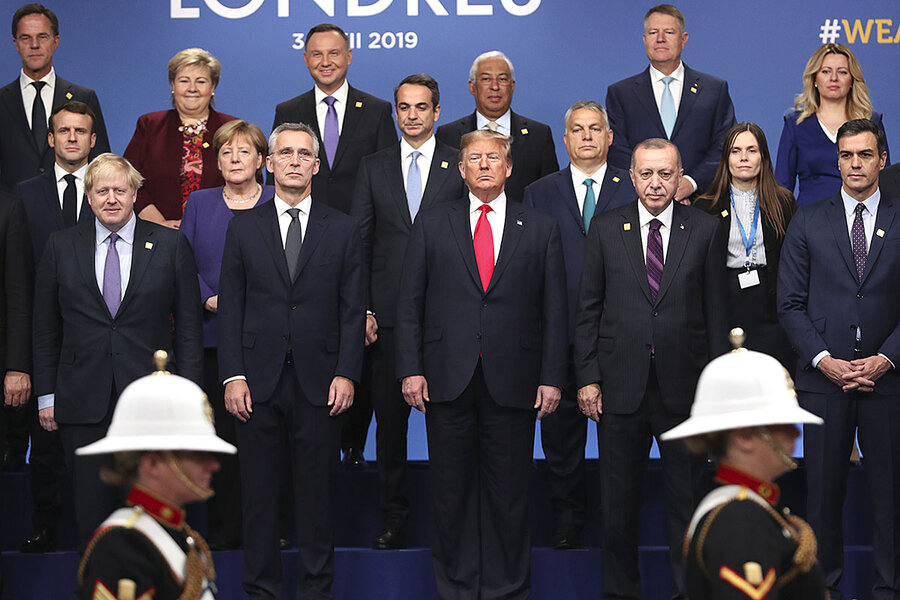Post summit, a NATO in search of common purpose
| London
There were times during last week’s openly fractious NATO summit that suggested the transatlantic alliance needed not more summitry, but intensive family therapy. And that its 70th -anniversary get-together might end not with the traditional upbeat communiqué, but with what lifestyle-guru Gwyneth Paltrow described, upon splitting with her then-husband, as an act of “conscious decoupling.”
That could still happen, despite the fact that the closed-door meetings were actually less contentious than in recent years, and the communique did duly appear. There’s still every chance that the security bond between the U.S. and Europe will progressively weaken, and that European states will build up their military capacity and security policies more independently.
Yet the main significance of the summit was to focus minds on the daunting questions NATO will have to answer if it is to survive in its current form for another seven years, let alone another 70.
Put simply: What is NATO for? What common interests, what shared security concerns and potential threats, now bind its member states?
The questions aren’t new. But political tensions within the alliance, put on public view with the instances of overt insult and ridicule among a number of last week’s summit participants, have made them unavoidable.
When the mission was clear
For NATO’s first four decades, its mission was clear: to bind the United States and the democracies of Western Europe in mutual defense against the Soviet Union. After the dissolution of the USSR, it moved to adapt its role to a post-Cold War Europe. In the late 1990s, with the U.S. and Britain taking the political lead, it deployed its air power during the war in Kosovo. It also began integrating formerly Soviet-dominated states in Eastern Europe. In response to the Sept. 11 Al Qaeda terror strikes in the U.S., the alliance for the first time formally invoked Article 5 of its charter – the commitment that an attack on one member would be deemed as an attack on all of them.
But the world in which NATO operates has been changing dramatically, with especially jarring effects over the past few years.
The U.S. now shares the superpower stage not with the Soviet Union but China. Russia, though nowhere near that league in economic terms, has reasserted itself: invading neighboring Ukraine and annexing Crimea, and establishing a first, post-Soviet foothold in the Middle East by intervening in Syria. In the Middle East, itself, Iran has been extending its military and political reach into Iraq, Syria, and Lebanon.
And crucially, the U.S. has pivoted its geopolitical focus away from Europe toward China. That process began under President Barack Obama, but has greatly accelerated under President Donald Trump. He has described the alliance as “obsolete” and accused many of its European members of ripping off Washington by not paying more of the costs of defense.
Even before last week’s summit, NATO’s internal rifts had been made manifest by two major security challenges: the war in Syria and Iran’s efforts to produce a nuclear weapon.
From the outset of the Syrian civil war, the NATO allies balked at the idea of major joint action, with Russia ultimately stepping in to tilt the balance in favor of President Bashar al-Assad. Then, earlier this year, one NATO member, Turkey, with a green light from President Trump, occupied northern Syria and attacked the U.S.-allied Kurds – without notifying, much less consulting with, other members of the alliance.
On Iran, despite the opposition of NATO’s European states, Mr. Trump unilaterally withdrew from a 2015 international agreement aimed at limiting its nuclear program.
In the run-up to the summit, French President Emmanuel Macron suggested the alliance was “brain dead” – ironically leading Mr. Trump to dress him down publicly, defending an alliance he himself had suggested was past its sell-by date.
Still, President Macron insisted he’d been right to speak up, if only in order to deliver a wake-up call.
It appears to have been heard. Amid the boilerplate text of the final communiqué, there were specific references to the new array of challenges facing member states: “Russia’s aggressive actions … terrorism … instability beyond our borders … cyber and hybrid threats.” There was even a reference to “China’s growing influence,” described as presenting “both opportunities and challenges that we need to address together.”
But another provision implicitly recognized that drawing up such a list was a long way from creating a commitment to shared action. It spoke of “a forward-looking reflection process” in order to “strengthen NATO’s political dimension, including consultation” among its member states.






